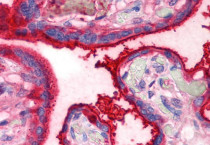ARG65462
anti-Transferrin antibody [HTF-14] (low endotoxin)
anti-Transferrin antibody [HTF-14] (low endotoxin) for ELISA,Functional study,ICC/IF,IHC-Formalin-fixed paraffin-embedded sections,Radioimmunoassay,Western blot and Human,Pig,Rabbit
Overview
| Product Description | Azide free and low endotoxin Mouse Monoclonal antibody [HTF-14] recognizes Transferrin |
|---|---|
| Tested Reactivity | Hu, Pig, Rb |
| Species Does Not React With | Cow, Dog, Hrs, Sheep |
| Tested Application | ELISA, FuncSt, ICC/IF, IHC-P, RIA, WB |
| Specificity | The antibody HTF-14 recognizes an epitope located in the N-terminal domain of human serum transferrin, a 77 kDa single polypeptide chain glycoprotein (member of the iron binding family of proteins). It is synthesised in the liver and consists of two domains each having a high affinity reversible binding site for Fe3+. |
| Host | Mouse |
| Clonality | Monoclonal |
| Clone | HTF-14 |
| Isotype | IgG1 |
| Target Name | Transferrin |
| Antigen Species | Pig |
| Immunogen | Purified porcine transferrin. |
| Conjugation | Un-conjugated |
| Alternate Names | Beta-1 metal-binding globulin; Siderophilin; Transferrin; PRO1557; TFQTL1; Serotransferrin; PRO2086 |
Application Instructions
| Application Suggestion |
|
||||||||||||||
|---|---|---|---|---|---|---|---|---|---|---|---|---|---|---|---|
| Application Note | * The dilutions indicate recommended starting dilutions and the optimal dilutions or concentrations should be determined by the scientist. |
Properties
| Form | Liquid |
|---|---|
| Purification | Purified by precipitation and chromatography. |
| Purification Note | 0.2 µm filter sterilized. Endotoxin level is <0.01 EU/µg of the protein. |
| Buffer | PBS |
| Concentration | 1 mg/ml |
| Storage Instruction | For continuous use, store undiluted antibody at 2-8°C for up to a week. For long-term storage, aliquot and store at -20°C or below. Storage in frost free freezers is not recommended. Avoid repeated freeze/thaw cycles. Suggest spin the vial prior to opening. The antibody solution should be gently mixed before use. |
| Note | For laboratory research only, not for drug, diagnostic or other use. |
Bioinformation
| Database Links | |
|---|---|
| Gene Symbol | TF |
| Gene Full Name | transferrin |
| Background | This gene encodes a glycoprotein with an approximate molecular weight of 76.5 kDa. It is thought to have been created as a result of an ancient gene duplication event that led to generation of homologous C and N-terminal domains each of which binds one ion of ferric iron. The function of this protein is to transport iron from the intestine, reticuloendothelial system, and liver parenchymal cells to all proliferating cells in the body. This protein may also have a physiologic role as granulocyte/pollen-binding protein (GPBP) involved in the removal of certain organic matter and allergens from serum. [provided by RefSeq, Sep 2009] |
| Function | Transferrins are iron binding transport proteins which can bind two Fe(3+) ions in association with the binding of an anion, usually bicarbonate. It is responsible for the transport of iron from sites of absorption and heme degradation to those of storage and utilization. Serum transferrin may also have a further role in stimulating cell proliferation. [UniProt] |
| Cellular Localization | Secreted. [UniProt] |
| Calculated MW | 77 kDa |
Images (2) Click the Picture to Zoom In
-
ARG65462 anti-Transferrin antibody [HTF-14] (low endotoxin) IHC-P image
Immunohistochemistry: Paraffin-embedded Human placenta tissue stained with ARG65462 anti-Transferrin antibody [HTF-14] (low endotoxin).
-
ARG65462 anti-Transferrin antibody [HTF-14] (low endotoxin) WB image
Western blot: Human Transferrin with different lodings. 1) 5 µg, 2) 3 µg, 3) 1 µg, M) marker, 4) 1 µg, 5) 3 µg, and 6) 5 µg stained with ARG65462 anti-Transferrin antibody [HTF-14] (low endotoxin).
Lane 1-3: Reducing condition. Lane 4-6: Non-reduring condition.
Clone References









